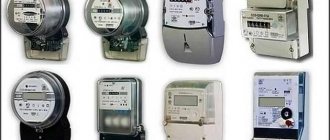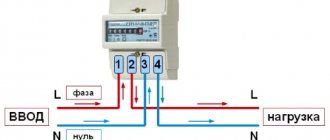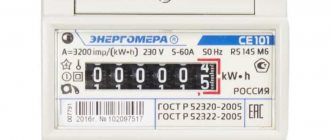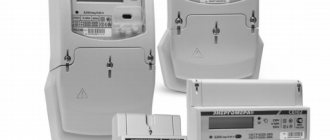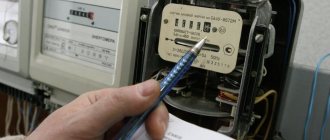Even if an electric meter is not installed in your residential premises, you will still have to pay for electricity (regardless of whether you consume the resource or not). The fee is set by region according to consumption standards.
This article provides information on how to pay for electricity if there is no meter (it is damaged, stolen, broken) or if the user does not allow employees of the energy sales company to take readings from the meter.
How to pay for electricity without a meter?
When a consumer has an electric meter installed, there are no questions about how the fee is calculated. Simply, the amount of kWh spent (according to the electric meter readings) should be multiplied by the tariff that is established in the region. The result obtained will be the amount that needs to be paid for electricity.
It is more difficult to determine how electricity charges are calculated without a meter. Similar situations include cases when there is no electric meter, or when there is one, but:
- Employees of the energy sales company are not allowed to the electric meter to check its integrity and take readings;
- The readings for the reporting period were not transferred to the energy sales company (in accordance with the established procedure);
- The device is faulty (broken or the verification period has expired);
- During the verification, it was determined that the device was damaged intentionally.
Each of the above cases is described in detail in the Rules for the provision of public services (hereinafter referred to as the Rules). There is also a method for calculating fees for electricity services without metering devices.
This document was approved by the Government of the Russian Federation by its Resolution No. 354 of May 6, 2011. “On the provision of utility services to owners and users of premises in apartment buildings and residential buildings.” After its entry into force, this document underwent many changes and improvements.
In the context of these rules, we will analyze in detail the different options for paying for electricity without a meter.
Calculation of energy consumption by meter
For the population living in private houses and apartments and equipped with metering elements, it is quite easy to calculate the electricity consumed over a certain period of time. To do this, you just need to look at the readings for the current month, subtract the readings for the previous month from them and multiply by the current tariff. In this case, you need to be careful because only the numbers indicated before the decimal point are taken into account. We described in detail how to take readings from an electric meter in a separate article.
If there is an accounting element and an agreement has been signed with the supplier on a two-tariff or multi-tariff consumption regime, then a special calculation is carried out. The cost of each kilowatt/hour depends on the time of day. During the day, the price of electricity will be more expensive, and at night it will be cheaper. Moreover, this meter is a modern electronic device that records consumption and displays it on the display. Without difficulty, at any time it is possible to view separately the readings for daytime and nighttime, and then calculate in the same way by multiplying the difference by the corresponding tariff. The cost of one kWh directly depends on the type of residential premises:
- with gas stove;
- with electric stove.
For houses located in a village or town, the standards may also differ.
Prices for legal entities and enterprises differ from prices for the population and depend on the total market trading for a particular region. You can view this information on the website of the guaranteeing electricity supplier.
The electric meter is faulty: how to calculate the monthly payment?
If for some reason your meter is faulty (the verification period has expired, the device is broken during repairs, stopped working for other reasons, or is simply stolen) or is recognized as such during an inspection by a representative of the energy sales company, it is important to know how the payment for light is calculated in this case .
According to clause 59 of the Rules, the first thing that is determined is the moment of the event (from what time the electric meter is considered faulty/lost).
Such a moment could be:
- the date the subscriber contacted the energy sales company with a statement about the malfunction/theft of the electricity meter;
- the date of drawing up the report regarding the malfunction of the electric meter, which is drawn up by an employee of the energy sales company during the inspection;
- expiration date of the electric meter inter-verification period.
If it is not possible to determine the exact date, then the payment period/month in which the “event” occurred is taken as the “reference point”.
From this moment on, the user will be transferred to paying for electricity based on average monthly consumption (calculated based on the last 6 months). At the same time, according to the average monthly payments, the subscriber will be charged only for 3 months, and then he will be transferred to payments according to the standard, which is significantly more expensive. To reduce costs, you should install a new electricity meter promptly.
Is it possible to appeal an act of unaccounted (unaccounted) consumption?
Arbitration courts in most cases say that the act of unaccounted consumption and the issued invoice do not indicate a violation of consumer rights.
Therefore, they cannot be appealed. But courts often do not take into account that failure to pay a bill entails a violation of rights in the form of a power outage. If you are an entrepreneur, it would be better to pay part of the invoice first. Then apply to the arbitration court with a claim for recovery of unjust enrichment, that is, the previously paid amount on the invoice. As part of this dispute, it will be necessary to prove the absence of grounds for issuing an invoice. When filing a claim, you can apply for interim measures in the form of a ban on turning off electricity.
How to pay for electricity if the meter is damaged?
Here we will consider the option of how the payment for light is calculated in the case when the electric meter is damaged intentionally or electricity enters the house/apartment, completely bypassing the meter.
For the consumer, this situation is the most unfavorable. Here the calculation is carried out in accordance with clause 62 of the Rules.
If, during the inspection, the inspector discovered that the electric meter was damaged intentionally and takes into account the consumed kilowatts for the benefit of the subscriber, or electricity was supplied to the apartment/house bypassing the meter altogether, then severe measures will be taken against such a consumer. In this case:
- The inspector inspects the premises of the apartment/house (in this case he has the right to do this) and records the number and power of all available electrical appliances;
- After this, the daily electricity consumption is calculated (provided that absolutely all electrical appliances work constantly);
- It is calculated how much energy the household consumes in this mode over the last 6 months;
- The total number of kilowatts received is multiplied by the tariff. The result obtained is the amount that the subscriber will be charged for payment.
The amounts of such charges are several times higher than the standard amounts of payment for electricity according to the meter.
It should be noted that the payment for light in a similar way (based on the maximum possible consumption) will be charged until the user eliminates the malfunctions and violations.
It is important to remember that if representatives of the electricity network visited you with an inspection less than 6 months ago, and such an inspection did not reveal any violations, then, based on the maximum possible consumption, the calculation of electricity charges will be carried out from the date of the previous visit of representatives of the energy sales company.
Calculation for non-residential public premises
The calculation of electricity consumed for general house needs, abbreviated as ONE, was recently included in the utility bill as a separate line item. There have been changes since January 2022, but this figure cannot disappear anywhere, because someone has to pay for electricity. These needs include the following:
- Lighting of the entrance, staircase.
- Power supply for intercoms and video cameras, if they are installed to maintain order.
- Power supply for elevators.
- Other types of energy losses in networks of apartment buildings.
Naturally, the amount of payment directly depends on the meter readings, but their installation for monitoring networks of non-residential premises does not always exist. If there is a meter, then each apartment will pay an amount corresponding to the living area. Still, this option is calculated based on power and depends on it; the situation with metering without a meter is slightly different.
How are such calculations carried out if the accounting element does not exist? As with residential premises, there is a general standard established by the regional administration. After which this indicator is multiplied by the area of the common building and by the area of a single apartment in a multi-storey building. Each region has its own standard and it is the key value for calculating electricity consumption.
As you can see, at present, a working electric meter for both residential and public premises and consumers is the only effective method of paying less, and only for the energy actually used. Now you know how to calculate electricity according to the standard and understand how expensive it is to pay electricity bills without a meter!
It's simple! But how is electricity payment calculated without a meter? Current legislation reduces the variety of life situations to the following options:
- there is a meter, but its readings were not transmitted on time (in accordance with the established procedure)
- There is a meter, but it turned out to be faulty (it broke down, the verification period has expired)
- There is a meter, but representatives of the energy supply service provider are not allowed to see it
- there is a meter, but upon inspection it turned out that it was deliberately damaged
- Finally, there is simply no counter. And this situation is by no means uncommon.
How the fee for electricity supply service is calculated in each of these cases is described in detail in the Rules for the provision of utility services. This document was approved by government decree No. 354 of May 6, 2011.
There is no electricity meter at all: how to pay for electricity?
Of course, housing began to be equipped with electricity meters a very long time ago (en masse back in Soviet times), but to this day you can find premises where there are no such meters. This often occurs in apartments converted from former dormitories, etc.
If there is no electricity meter in the apartment/house, electricity charges will be charged according to the standard. The methodology is described in paragraph 42 of the Rules. Here three indicators are taken into account, namely:
- the number of persons who permanently/temporarily reside in a particular premises;
- electricity consumption standard (set separately for each region of the country by local authorities);
- electricity tariff that applies to a specific type of consumer.
By multiplying these values, you get the amount that is billed to the subscriber for payment.
If we consider how profitable such a payment will be, we should take into account the number of persons officially registered in the apartment/house:
- if there are actually more people living in an apartment/house than registered, then paying for electricity according to the standard may be more profitable;
- If there are actually fewer people living in an apartment/house than officially registered, then it is more profitable to pay for electricity according to the readings of the electric meter.
For greater specificity, it is advisable to find a decision from the tariff authority (in the region of residence), which approved consumption standards.
Standard if there is a meter
How to replace an electricity meter?
Sometimes situations arise when the meter is installed, but for a number of reasons the energy supply service additionally calculates energy consumption for a certain period.
There are no meter readings for a long time
If the device is located inside a house or apartment and is not accessible to the controller, the owner must submit meter readings to the subscriber service on a monthly basis. When no information is received for six months (in some regions after 3 months) (for example, due to the lack of tenants), the average monthly indicators are taken into account for this period and then automatically transferred to the standard type of payment.
No access to the device
When people live in an apartment or house, but inspectors cannot gain access to the devices, the owners are notified in writing of the date and time of the service representative’s visit. If the owner deliberately ignores these visits, then after three unsuccessful attempts to gain access to the meter, he will have to pay for electricity for 3 months at the average monthly tariff, and then at the established standard.
In case of breakdown
As soon as the meter fails, the owner of the apartment (house) is obliged to notify the supplier in writing. While the device is being changed, checked and installed in place, payment is recorded based on average indicators. But if the owner kept silent about the defect, and the inspector himself discovered a malfunction of the device or mechanical interference with it, they will proceed from the last paid indicator and the time when this event occurred.
Problems with the meter
What do consumption standards depend on?
Electricity consumption rates depend on the following points:
- number of rooms in the house/apartment;
- type of installed stove (gas or electric);
- number of residents (if 1 person is registered, then the consumption rate will be greater than, for example, for one of the 3 registered). At the same time, the management company (HOA) has the right to control how many people actually live in a particular apartment. After such verification, the confirmed number of residents will appear in the calculations of electricity charges according to the standards.
Using a lower value of the conversion factor with the correct circuit for switching on the meter
Disturbances associated with the difference between the actual transformation ratios of CTs (VTs) of individual phases of the measuring complex from the coefficients used in calculating the consumption of electrical energy, as well as cases of a recorded increase in the ratio of the currents of the primary and secondary windings of the CTs, regarded as an increase in the transformation ratios of the CTs, are considered.
Incorrect and identical value of the calculated coefficient in all phases of a 3-element or 2-element circuit
Underaccounted electrical energy is determined by the formula:
| , | (13) |
where K is the correct value of the conversion factor for electricity meter readings in kW. h;
Kr – incorrect value of the conversion factor.
Incorrect and different conversion factor values for different phases of a 3-element circuit
Underaccounted electrical energy is determined by the formula:
| , | (14) |
where K1, K2, K3 are the correct values of the conversion factor for phases A, B, C, respectively.
Incorrect and identical value of the conversion factor in two phases of a 3-element circuit
Underaccounted electrical energy is determined by the formula:
| . | (15) |
Incorrect value of the calculated coefficient in one of the phases of the 3-element circuit
Underaccounted electrical energy is determined by the formula:
| . | (16) |
Incorrect value of the conversion factor for 1-phase metering
Underaccounted electrical energy is determined by the formula:
| . | (17) |
Additional Information
In recent years, the Russian government has been introducing measures aimed at 100% equipping residential premises with meters for electricity consumption. In order to further motivate consumers to switch to paying according to the electric meter, and not according to the standard, it is planned to gradually increase them (standards). Depending on the region, the increase will be 10-20%. In addition to the already common increase in electricity tariffs (usually 5-10% per year), the difference becomes more than significant.
Summarizing the above, it can be argued that electricity without a meter will cost consumers more and more. It is advisable to think about equipping your home with an electricity meter today. This way, you can avoid overpaying every month, but pay only for the number of kilowatts that were actually used.
What needs to be proven in court to win a dispute over unmetered electricity consumption?
- The metering device was checked with violations that did not allow the consumer to provide their evidence.
- The act of unrecorded consumption has inaccuracies that indicate its unreliability and inadmissibility.
- The fact of unaccounted consumption is not confirmed by the act of unaccounted consumption, and there is no other evidence.
- There was no impact on the metering device. To prove this, it may be necessary to conduct an examination or involve an energy specialist in the case.



